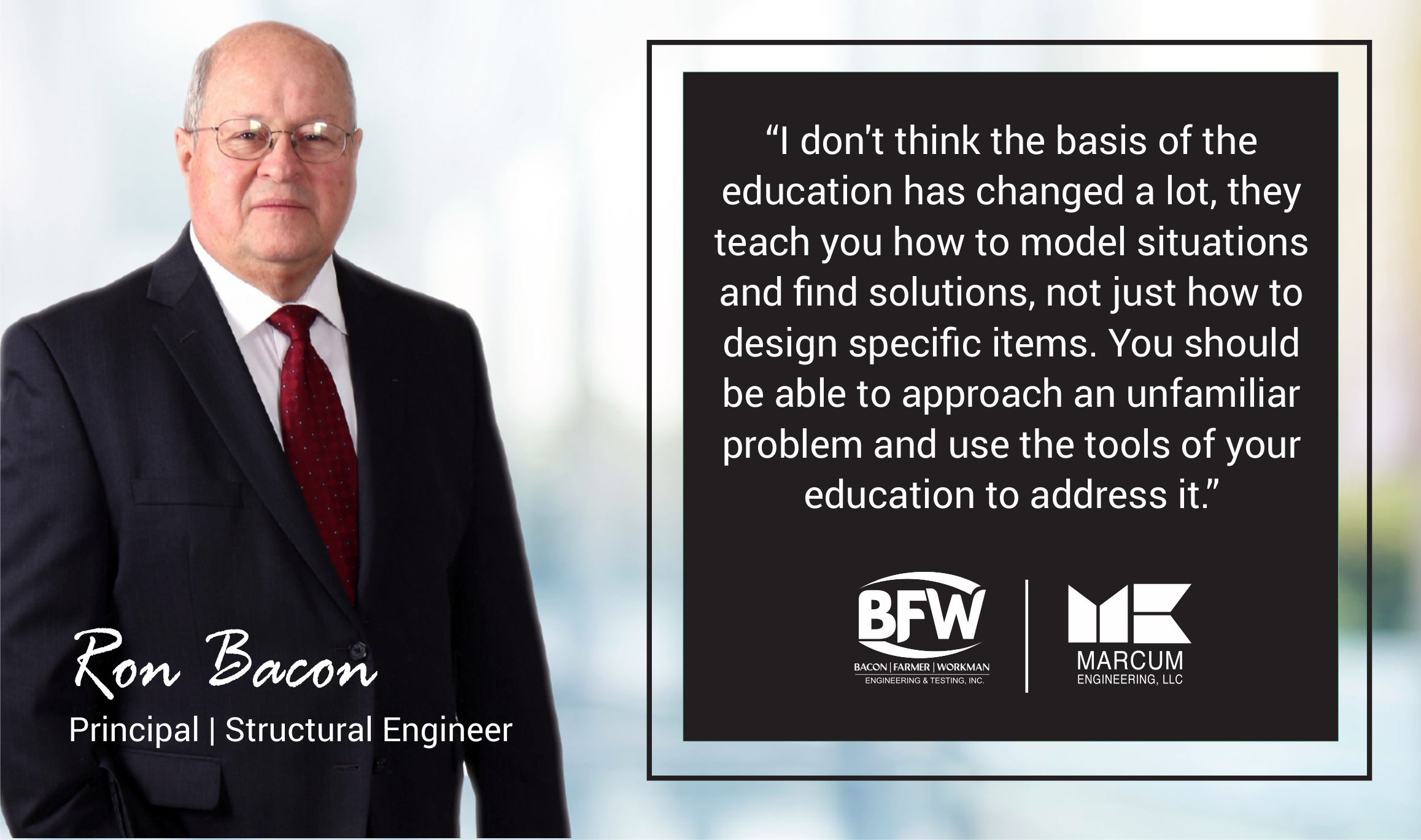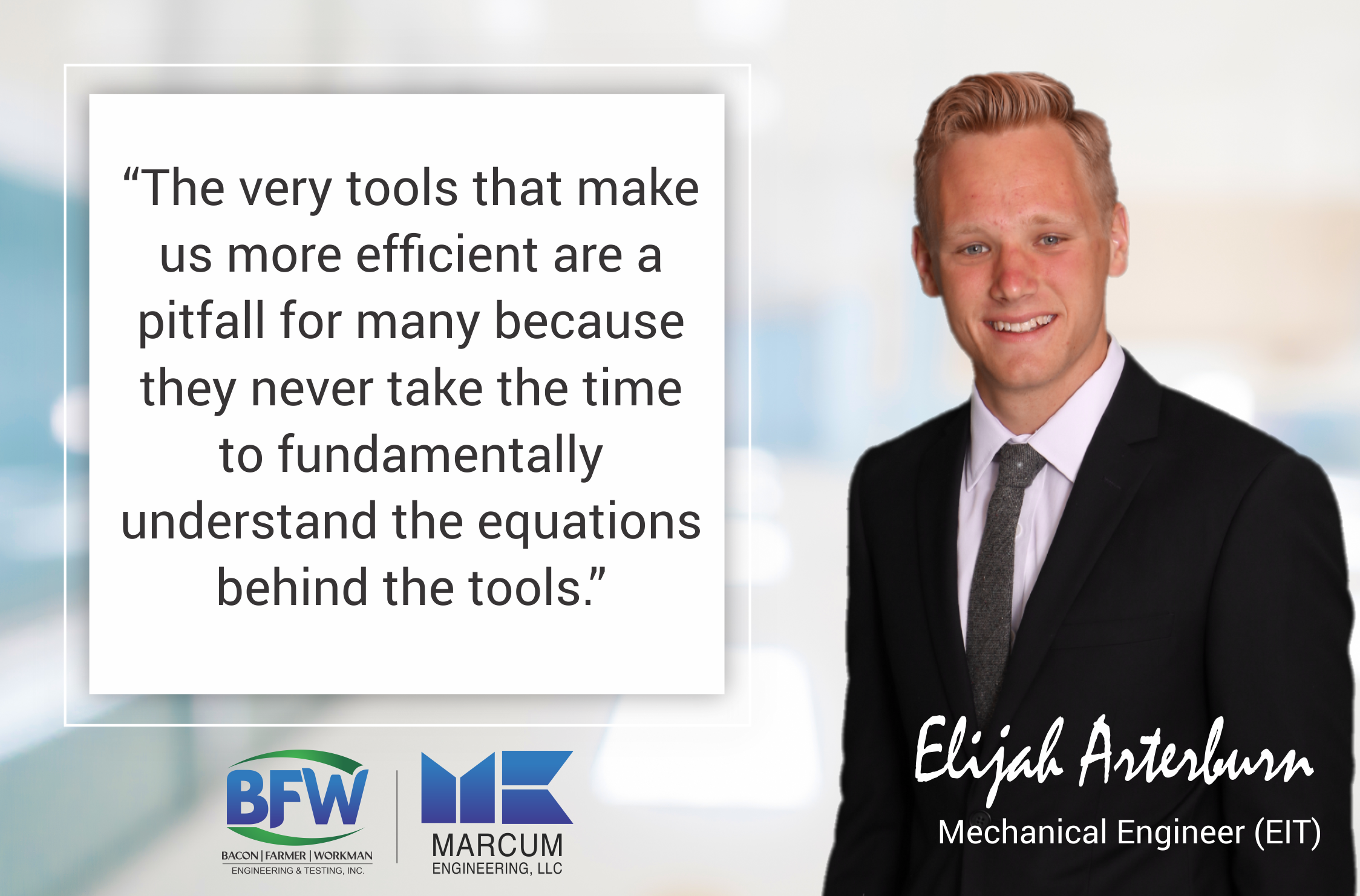Old School, New School: Engineering Then & Now
Is new always better? Or is it the old way or the highway? It’s no secret that modern engineering takes advantage of many technological advances that simply did not exist in the past. Even the tools we used a couple of decades ago have changed. With this in mind, we asked ourselves, which is better, analog or digital?
To answer this question, we asked Ron Bacon, Principal/Structural Engineer of the old school engineering camp, and Elijah Arterburn, Mechanical Engineer (EIT), who is a recent engineering graduate from the University of Kentucky.
How do You Fit a Basement into Your Pocket?
What did an engineering degree look like? What does it look like today? Ron is quick to point out that the spirit of both is the same; using the tools and methods at your disposal to solve a problem. However, the tools have changed quite a bit from when he was in school.

“I don’t think the basis of the education has changed a lot, they teach you how to model situations and find solutions, not just how to design specific items. You should be able to approach an unfamiliar problem and use the tools of your education to address it.
We did use more textbooks and computers weren’t readily available. The computer we used occupied the entire basement of a math building and we submitted punch cards to use it. We could pick up our output the following day. I was part of the first class to use digital calculators all the way through, and only learned a slide rule as an aside; I just barely missed that era.
Engineers tend to embrace new technology quickly, so when they became available calculators were everywhere. Surveyors had books that contained nothing but trigonometry tables with sine, cosine, and tangent values for various angles. Those became obsolete overnight when trig capabilities became available on calculators. We had one class that taught us how to use drafting methods to solve engineering problems. That class also went away quickly. The soils lab bought an early standalone refrigerator-sized computer, with the intent of connecting it to testing equipment and generating reports. It cost about a quarter of a million bucks, and after it arrived they discovered they also had to buy operating software at an additional cost.”
Elijah, like the rest of us, has a computer profoundly more powerful than the one that sat in the basement of Ron’s math building basement right in his pocket. Calculator technology is now wholly relegated to a built-in application on your smartphone; even then, you won’t find it mentioned at the next Apple Keynote. We asked Elijah to describe his engineering tools.
“We were taught to use a lot of computational tools, in fact in almost every upper-level class in our program at the University of Kentucky requires some kind of software toolset to do calculations, no matter how complicated or esoteric. For example, we were taught to use ANSYS in our Statics and Solids courses to determine stress, strain, and torsion in structural beams and components.
We also used MATLAB in many different courses to solve complex equations iteratively by coding solutions. We were taught a program called EES (Engineering Equation Solver) that had many built-in databases with thermal and fluid properties for heat transfer and thermodynamics problems. I also took an entire course on Computational Fluid Dynamics in which we used a Linux-based program to study fluid flow patterns and heat transfer characteristics.
I think the largest contrast is that even 30 years ago no one in an undergrad engineering program could have dreamed of solving problems with half the equations that we can solve using these tools. The principles are the same, but the tools we use are vastly different and have exponentially more computational power than tools from even 15 years ago, not to mention forty or fifty years ago.”
Just Because It Can, Doesn’t Mean You Shouldn’t
Is it the journey or the destination that is most important? Is it more valuable to arrive at the answer, or to have the answer come to you? That is the age-old debate when it comes to analog and digital. We asked Ron for his thoughts.
“One thing I heard a lot early in my career is that you should already have some idea of what an answer will be before you ever start up the computer. I think the ability to recognize an out-of-whack answer is fading away. On the other hand, the ability to rapidly view a 3D model from any viewpoint is immeasurably better than the old two elevations and a plan view method.”
To put it simply, ask a baby boomer how to get somewhere and they’ll probably give you a list of directions based on their encyclopedic knowledge of the area. Ask someone younger, and they’ll probably just tell you to punch it into Google Maps and call it a day. Is one solution better than the other? In a way, isn’t knowledge power? Maybe, in this case, the power belongs to the thing that has the knowledge. Elijah agrees with this line of reasoning.

“The tools that we were taught to use make us more efficient, but whether or not they make us better is a matter of debate, and certainly depends on the individual. The very tools that make us more efficient are a pitfall for many because they never take the time to fundamentally understand the equations behind the tools.
There are a lot of complex tools that we have available today to practically do the work for us, but without a foundational understanding of the roots of the subject, we cannot use the tools accurately or sometimes even appropriately. Old school techniques are the foundation to all the complicated computational tools that we use today and it is still important to understand those ‘old school’ methods and theories before jumping into the use of a lot of the tech that we have available today.”
According to both Ron and Elijah, praise the tools, but do your homework.
Computers, Like All Tools, Enhance Your Knowledge
Ron emphasizes the power of knowledge. Computers, like all tools, enhance that knowledge. After all, a computer still needs input; it can’t spontaneously decide to become an engineer. There is nothing to inspire it or to give it the drive to do these calculations and computations without our inspirations and our drive. However, as tools, they make our knowledge more potent.
“The mechanics of how things work hasn’t changed. The principles of analysis haven’t changed, either. What has changed is how easy it is to examine a variety of combinations of loads and components.
Back in the day, you might have chosen just one or two types of components and only checked a few conservative load combinations, now you can check many more components and load combinations. It allows the design to be much more refined and efficient.
Archimedes, Da Vinci, Eiffel, and Roebling didn’t need computers. Yet, imagine what they could have done if they had them. In 40 short years, we went from slide rules to virtual modeling. Keep up with the technology, it changes daily.”
Elijah agrees although he takes Ron’s word for it.
“The principles of engineering and mathematics are still the same. I know this even if I wasn’t around in ‘the good old days’. There has been a lot of fine-tuning that we can afford to do now thanks to the help of modeling software and the like, but the basic principles are still the same – the laws of physics do not change.
A lot of ‘old school’ tools are still around, but most of them have a high-tech counterpart. I have a scale at my desk which I use on occasion I also have a pen and pencil for marking up drawings. But all those things I can relegate to a PDF on my PC if I wanted. The industry is full of some really smart people who have stayed on top of updating these tools for those who prefer computer-based design.”
Engineering is a Discipline that Celebrates Knowledge, No Matter the Source
In starting this article, we thought there might be a kind of rivalry between the old and new school engineers. However, what we found as an appreciation for the craft, no matter how it looks or where it comes from. Elijah summarizes this universal gratitude nicely.
“One of the great things about working with Engineers is that even the old guys are open to new technology. These guys love to learn, they love new gadgets, but most importantly they love to work accurately. If a tool makes me more efficient while producing a better final product, no one that I work with would ever question the tools or tech that I am using.

While I have been told, ‘I don’t know how you managed to do that,’ I have never been told to stop. One of the things that have always confused me and made me chuckle a bit is how some of the older engineers have so much paper piled on their desks. There are some guys in the office with stacks on stacks of paper! I will never understand how they get anything done, or how they have not lost whole projects down in those piles!
That being said, I do have a real respect for the way that these guys have always done things! The ‘old guard’ is smart! They have done hand calculations and done it the ‘long way’ for a long time and they have done a fantastic job. The hard work and reliability of the ‘old dogs’ are the foundation on which younger generations of engineers have built their ‘new tricks’.”
When the old dogs are eager to learn new tricks, and the new want to know how it used to be done, you cultivate a climate of discovery and innovation. Engineers, no matter their tools and their specific discipline, have always been the people that celebrate progress, no matter the path it takes.

Recent Comments